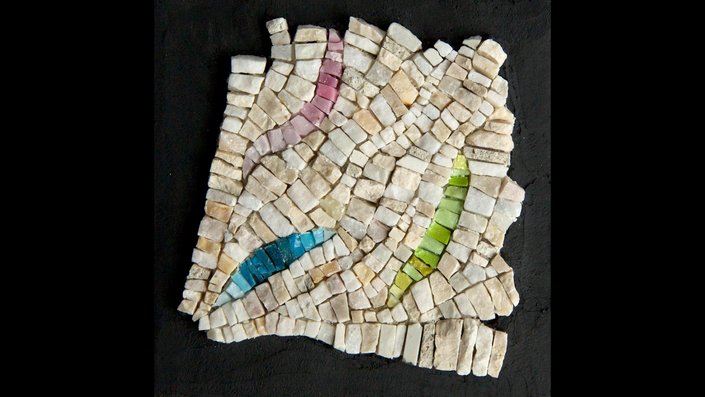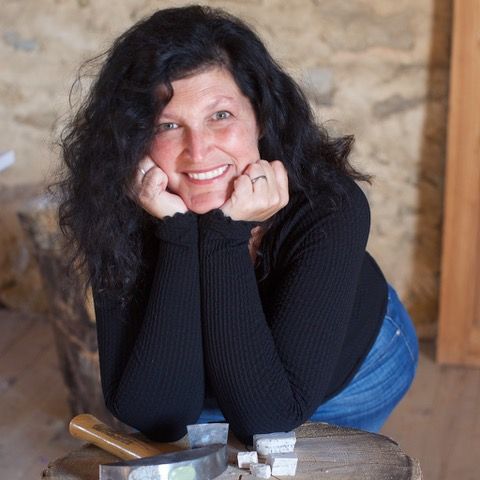
Gradations Five Ways with Anabella Wewer
Improve your art with sequencing, ordering, and nuance.
Watch Promo Enroll in Course
For Anabella Wewer color gradations are a storytelling tool. They express emotion, evoke a sense of opening (or closing!), a feeling of release and exuberance or constraint, provide surprises of unexpected or emerging color, and help her capture a moment in time. A master in color mixing and color theory, her favorite gradations are so simple, none of that advanced knowledge is really needed — in this online course, exclusively at Mosaic Arts Online, she has broken it down for us so we don’t have to think about it!
In this course you will learn:
• Gradations in reflectivity
• Importance of density of color and size of tesserae
• Successful gradations with a handful of colors
• How to source material
• Simple techniques for making gradations without wasting material or time
Though Anabella’s work is largely abstract, gradations are the key to capturing the beauty of a sunset, the gentle coloring of a flower, the folding of fabric, or the subtle sun-kissed blush in a portrait. Most of those are what she calls straight-up color gradations, from light to dark(er) and back again, in a perfect scale of values. But how many of those values do you need? Can you make it work with just a few? Most likely yes!, and Anabella shows you how and when to use more or less material to achieve the right effect.
But there are other ways to get a good gradation using just two colors. It’s all about proportions and how you mix them (or reveal them!), and in this course Anabella shows you four other ways to create beautiful gradations (with the help of a friend).
Gradations in reflectivity can be part of the story in mosaic, and Anabella shares all of those details with us. She shares practical, simple ways to figure out how density of color and the size of your tesserae affect the visual color mixing needed for smooth gradations in both representational or abstract works, and does so using both andamento and pointillist-style setting, which can be applied to crazy paving, stained glass techniques, and much more.
You will learn how to source material and simple techniques to practice and understand how to make gradations without wasting precious material (or time!). She invites you to really understand the materials available to you, look at them from all angles (and inside!), and leave no stone unturned (literally!) to find just the right piece for the right spot. Or not. Just pick a material or a color and handle it in such a way that you get a gradated effect. Your design sensibilities will dictate your path, but with this course you will have the know-how to make those decisions confidently.
Your Instructor

A graphic designer by profession, and a native of Caracas, Venezuela, Anabella is an internationally exhibited mosaic artist and passionate metalsmith. She is co-founder, and has been Creative Director of Black Box, a studio specializing in Web-based applications, since 1994. After discovering mosaics as fine art during a trip to the Vatican in 2004, she started taking mosaic classes in the United States, but quickly made the decision to train mostly in Italy. Her work is rooted in a sense of place and time, with a distinctive graphic feel that often incorporates type and her love of maps and fossils. Her passion for materials and history inform her work and push her to explore new territory grounded in time-proven rules and principles. Her background as a typographer guides her work, exploring the language of materials and technique to tell stories. "When I put hand to metal or stone, I aim to bring the viewer into a narrative, to provide questions to consider. I am intrigued by frozen moments in time; I like to imagine what came before and what follows. Place and time, their changing and their passing, and trying to capture their impermanence is my main artistic directive,” says Anabella of both her jewelry and mosaic work.
Anabella has studied Ravenna mosaic technique with Luciana Notturni, in Ravenna, Italy; stone micro-mosaic and opus vermiculatum with Arianna Gallo and Luca Barberini of Koko Mosaico in Ravenna; filati micro-mosaics with Maestro Carlo Meloni (Rome); abstract and modern mosaics with Verdiano Marzi (Ravenna/Paris), Dugald MacInnes (Scotland), Matteo Randi (Ravenna) and Dino Maccini (Piacenza) as well as with Valeria Manzo, Dagmar Friedrich and Laura Carraro at the Scuola Mosaicisti dei Friuli, Spillimbergo; and honed her skills using native materials with Rachel Sager; color in mosaics with Carol Shelkin, and got her beginnings under the guidance of Gina Hubler (Pennsylvania). Her native languages are Spanish and Portuguese, and she also speaks English and Italian. She lives in Macungie, Pennsylvania.
Course Curriculum
-
StartIntro and personal interview with Anabella and Tami (5:14)
-
StartPDF for download. Materials and resources
-
StartWhat we normally call color: value, tints, hues (3:37)
-
Start“Color” gradations (a.k.a. value/tint gradations) (4:14)
-
StartHow much material do you need? (3:13)
-
StartChanging colors across an area (2:17)
-
StartPicking materials for gradations (4:10)
-
StartIntroducing one color into another (color mixing gradations) (2:49)
-
StartColor mixing gradations examples (2:33)
-
StartOptical gradations with two colors (4:35)
-
StartMatte to Reflective/shiny gradations (2:19)
-
StartDensity of color in gradations (2:40)
-
StartOne color gradations using space (1:55)
-
StartDefacing as gradation (2:10)
-
StartPreparing materials for gradations (3:16)
-
StartIntroducing different materials to expand the gradation (7:14)
-
StartChanging colors with gradations (and tesserae with multiple colors!) (4:49)
-
StartFive ways summary~ (2:22)
-
StartBonus! Checking values through photography (2:47)
-
StartAnother Bonus! Preparing to make colored thin set “cakes” (8:12)
-
StartThin set "cakes" (3:44)
-
StartVariegated thin set “cakes” (5:09)
-
StartLightening things up! (3:02)
-
StartThin set “cakes” wrap up and insights (1:58)